Mid Pines Inn and Golf Club
North Carolina, United States of America
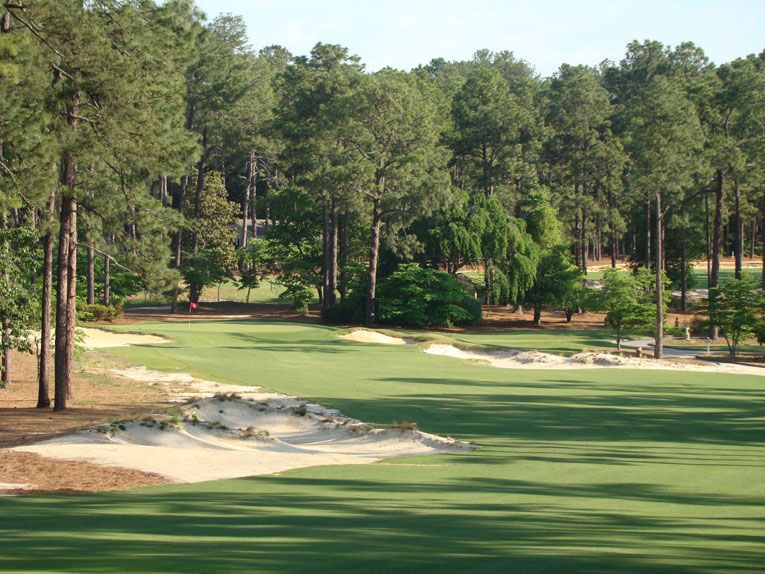
Mid Pines recent restoration makes it one of Donald Ross’s most authentic – and enjoyable – designs. Even better, it is open to the public.
When the Donald Ross Society first convened in 1990, Pinehurst was the logical place to meet. After all, Ross’s most intricate, complex design and the one on which he lavished the most attention over a 47 year period (!) is found here.
Yet, to gain a truer sense of Donald Ross‘s design philosophy of bringing pleasure to the greatest number, the golfer is well served to cast his eye farther a field than Pinehurst No.2. In nearby Southern Pines, there are three Ross gems that embody his general philosophy of golf as a pleasurable pursuit: Southern Pines (which makes for a wonderful study on how to route a course), Mid Pines and Pine Needles, which hosted the 1996 U.S. Women’s Open with such success that it was quickly awarded the 2001 U.S. Women’s Open during the closing ceremony! In fact, Pine Needles went on to host a third U.S. Women’s Open in 2007.
The origins of Mid Pines and Pine Needles trace the growth of American golf in the early decades of the twentieth century. After the conclusion of WWI, Richard Tufts found his resort turning away as many as 15,000 guests during the peak season of February and March. Realizing that his four courses at Pinehurst Country Club could not keep pace with the game’s growing demand, Tufts and Ross searched for more land. Back in 1920, they had their pick and found 5,000 acres of ideal terrain in what could be described – this time fairly – as the sand hills of North Carolina.
Located five miles from the village of Pinehurst, the terrain takes on a distinctly more rolling nature than nearer the village. The soil was of such sandy nature that many people referred to the area as the sand barrens. Whether one calls it the sand hills or sand barrens, Ross happily went straight to work on Mid Pines. Before too long, another course (a sixth) was required, and Tufts instructed Ross go to work across Midland Road on building Pine Needles late in 1926.
The diversity of the property leads to natural variety of the holes at Mid Pines. The holes that traverse the flatter interior of the course like the sixth, eleventh, the last 2/3 of the sixteenth and seventeenth holes feature shallower bunkers. Ross’s bunkering schemes create the playing interest for these holes. The bunkering at the majority of the other holes tends to be deeper and more expansive because the bunkers are cut into natural hillocks or built-up green pads.
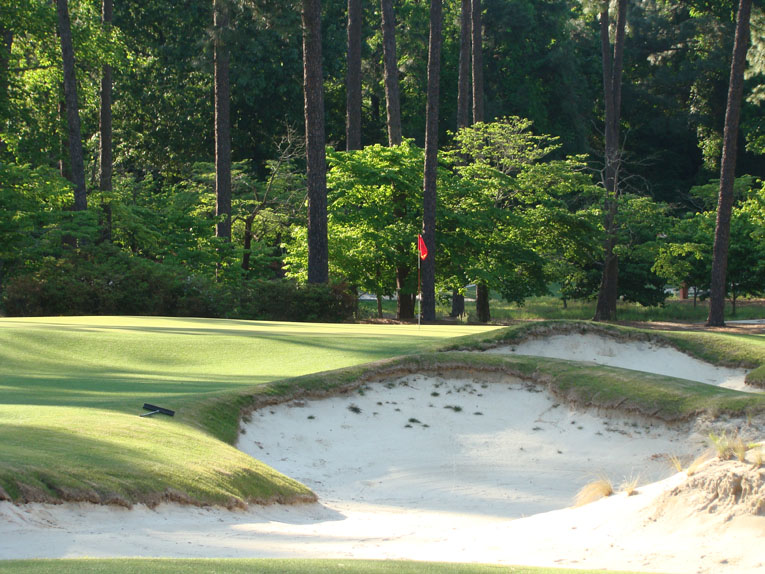
The bunkers on the flatter portion of the property like these near the sixteenth green are gracefully presented while …
Mid Pines opened to rave reviews and golfers flocked to it. Historian Chris Buie found this quote from XXX: “The Mid-Pines course, the latest achievement of Donald Ross, far surpasses the Pinehurst courses in scenic beauty and will probably prove a more severe test of golfing ability than either the championship course or the dreaded No.3 course at Pinehurst proper.”
The factors that conspired to make Mid Pines a success are evident to this day. The sides of the property are high and the course sits in its own secluded bowl with only a few homes on the perimeter. Donald Ross clearly thought highly of it as he selected it himself for his first course away from the Pinehurst village. From high on the fifteenth fairway, the golfer delights in the long views below and through the long leaf pines across the course. Some of the subtle slopes found across the property (e.g. the fairways at the fourth, seventh, and twelfth) were put to great use. A very inspired set of Donald Ross greens are a particular highlight. Kyle Franz’s green restoration project from June-August 2013 will recapture ~15,000 square feet of putting surface and restore several great hole locations (e.g. front right on seven, left of the knob on sixteen, back on eighteen). In addition, his work will greatly improved the eighth and ninth greens which were the only two non-Ross greens on the course. When done, the course will look and play like it did when Donald Ross was roaming around this special part of the golf world.
Holes to Note at Mid Pines
First hole, 390 yards; What an appealing sight: From the elevated tee, the golfer sees a broad fairway handsomely framed by mature long leaf pine trees that are well back from play. The green is located on a far hillock with four bunkers cut into the hillside. The rolling green at 43 yards is one of the deepest on the course and the golfer should note the day’s location from the tee before descending into the fairway.

If this view from the first tee doesn’t make you itch to play golf, you need to find a different pursuit!
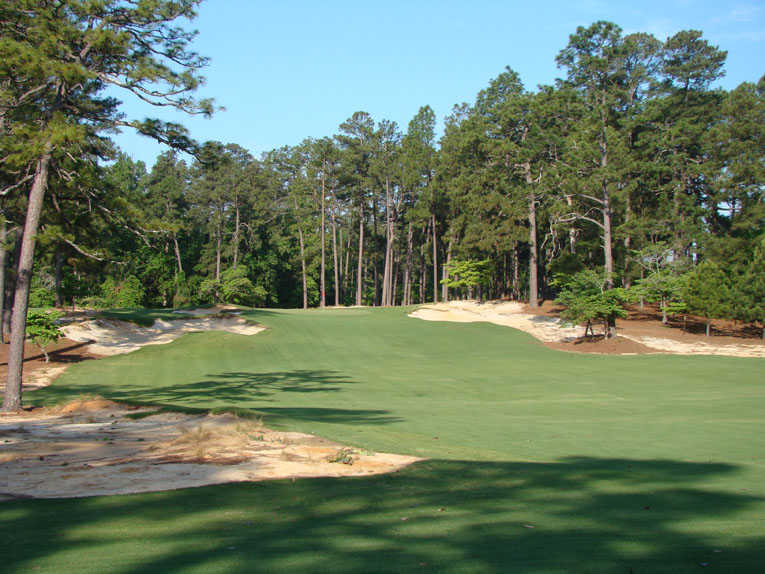
Gauging the depth of the day’s hole location becomes problematic once you reach the fairway valley floor.
Second hole, 190 yards; Working from one high point to another approximately 190 yards away, one imagines that Ross found this one shotter fairly quickly as he went through the routing process. Unusual for such a hole, the green is crowned (as opposed to being benched into the hillside) and falls away on all sides. When taken as a group – the sharply downhill eighth, the tightly bunkered eleventh, and the monstrously long 230 yard thirteenth – the one shotters at Mid Pines are a varied set where even the best are happy to make par.

The Golden Age architects were adept at cutting bunkers into natural landforms. Franz has recaptured the magic of Ross’s day.
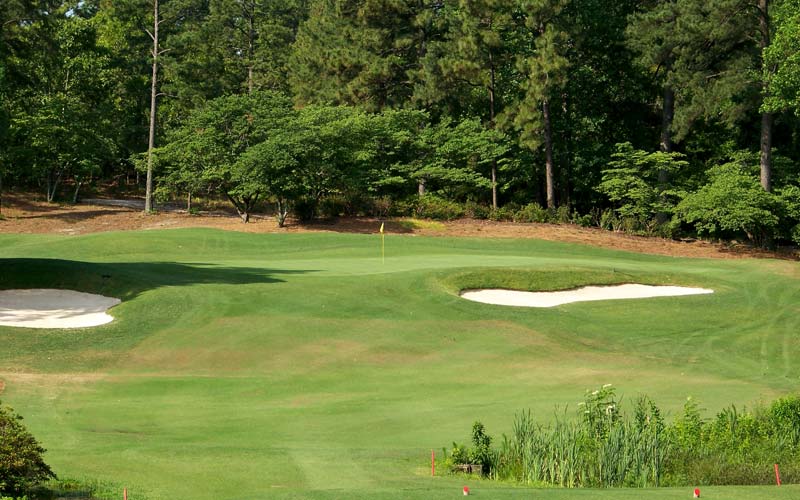
As seen in 2007, the bunkers at Mid Pines had a two dimensional quality. No more!
Fourth hole, 330 yards; This innocuous looking hole is a fooler thanks to the most severe green complex on either course. The plateau green angles away from the golfer to the right, and narrows toward its back. The approach shot with a short iron must be unusually precise as a ball can easily hit several feet onto the green only to spin off. A must-see hole for golf architecture fans.
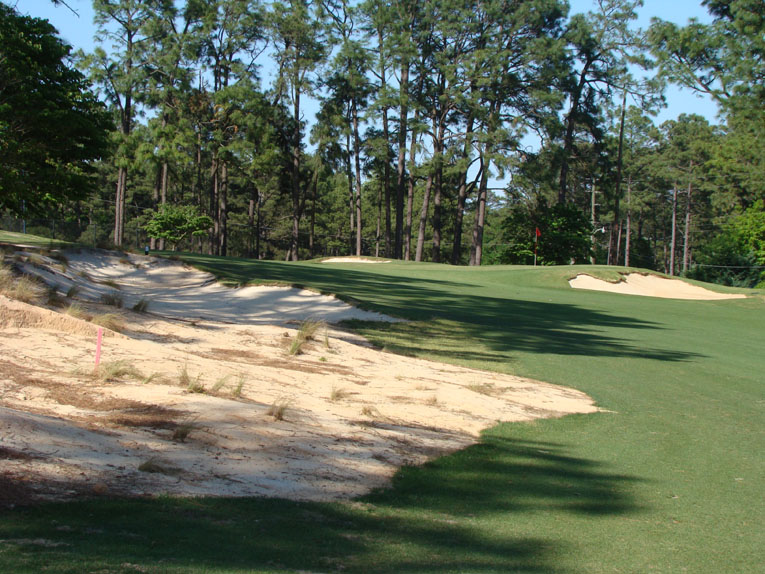
Playing angles abound and tee shots played near this left side hazard are rewarded with the ideal look down the long, narrow green.
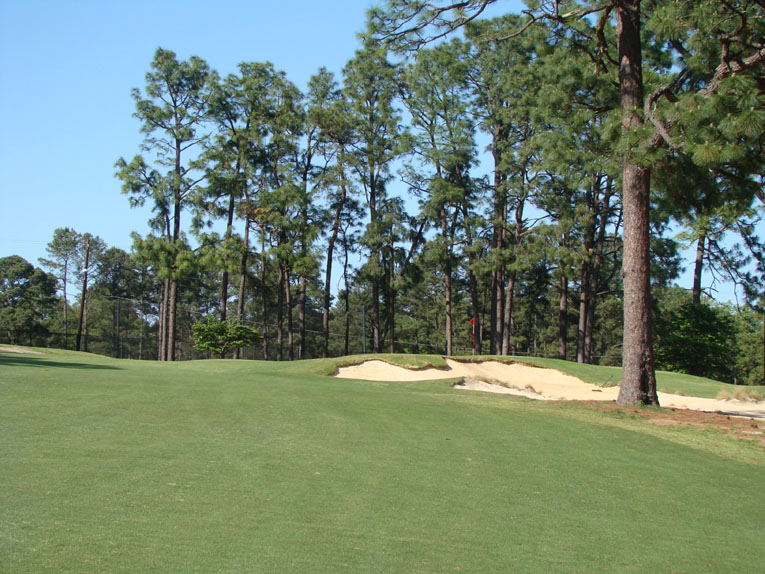
Franz expanded the left to right sloping fairway fifteen paces to the right. Weakly struck drives that dribble to the right can still finish in the fairway but suffer trouble ahead in the form of a tree and a horrible angle to approach the shallow green. The abundance of short fairway grass to the right actually makes this hole more challenging, all without the need to ever search for one’s ball.
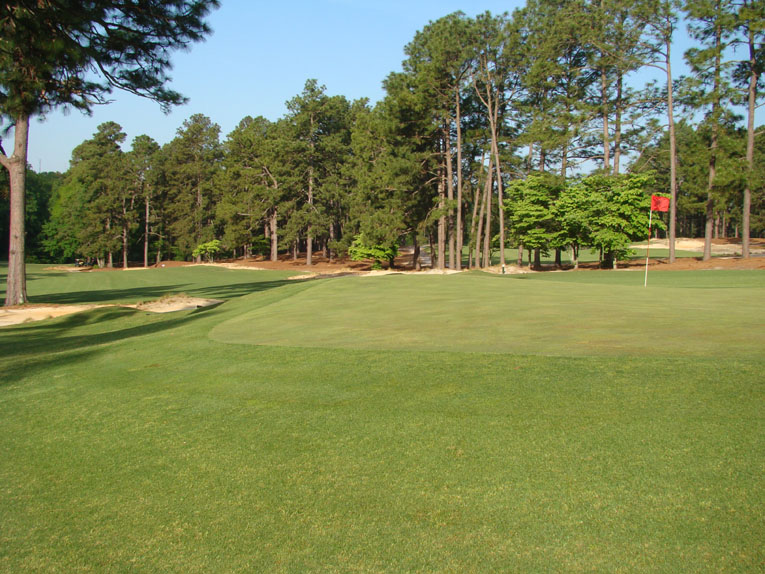
As seen from back right of this evil (!) Ross green complex, the tight turf is adept at whisking balls off the putting surface and well down the tightly mown surface.
Sixth hole, 520 yards; A mark of any good restoration is that the Golden Age architect’s design philosophies are allowed to flourish. Take this hole as a case study. In 2010, the last 100 yards featured a pine tree left and rough right. The lay up for 95% of the golfers was a straightforward affair, devoid of any interest. Down came the tree in the winter of 2012 and the fairway was extended well right to the edge of the sandy floor. Now options exist. Golfers can elect to go long left toward the green or lay up to the right in what is now fairway to enjoy the best look at certain hole locations. Ross would be proud that this hole’s full potential has been realized.
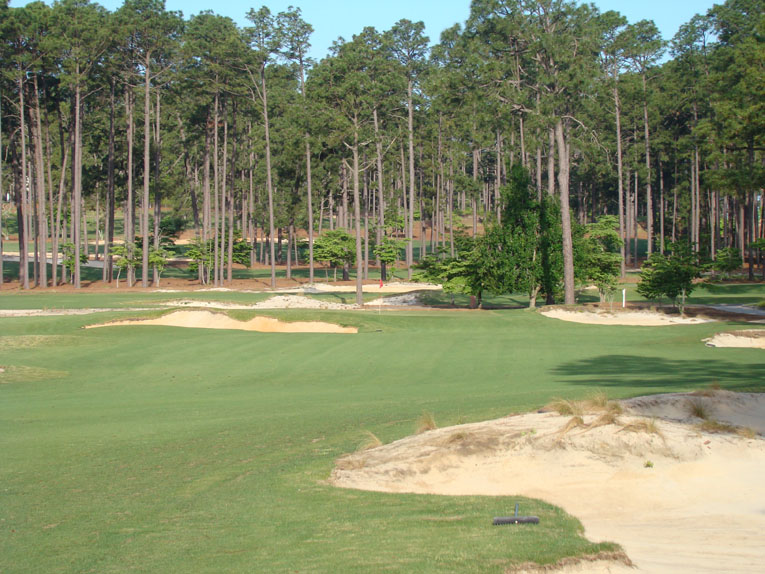
… the short fairway grass has been extended well to the right. Note how Franz restored the greenside bunker’s high left side.
Seventh hole, 400 yards; While its playing corridor may be straight, the seventh is full of nuanced playing angles. Push the tee ball slightly and the fairway contours shove it farther right from where the approach to the green is blind. Stay in the left third of the fairway to enjoy a full view of the putting surface. In addition, Franz was especially impressed by a level area in the left side of the fairway. Too subtle for the occasional golfer to even recognize, Franz believes that Ross lightly massaged this portion of the fairway to give the golfer an ideal stance to go along with the better optics. Ahead at the green, Franz reclaimed front and back right hole locations, both of which add much to the playing variety of the hole. All told, Ross got the absolute most out of this piece of the property. Remember: A gradual slope like the one found here is rarely an architect’s best friend. Fortunately, Ross expertly used it to advantage.
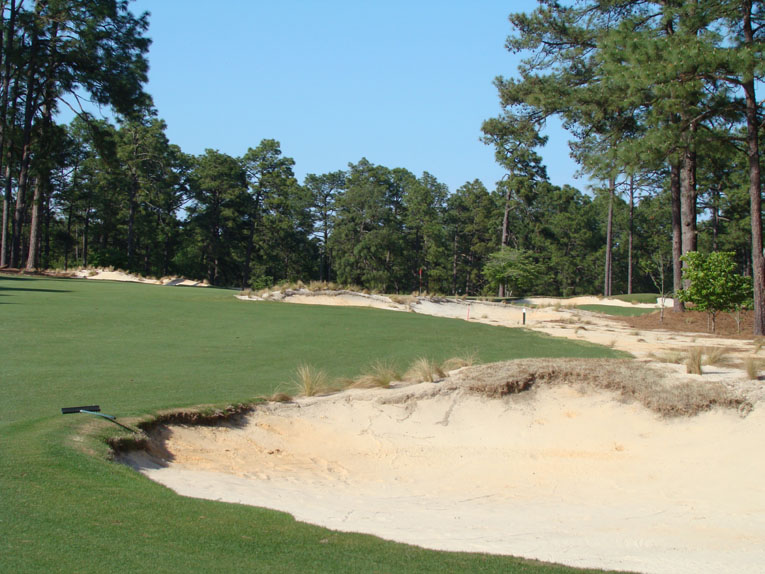
The natural slope of the land shunts tee balls to this area from where the approach shot is blind over the beautifully conceived bunker short of the green.

Meanwhile, a drawn tee ball that stays down the left provides the golfer with an entirely different (and better!) perspective from which to play his next shot.
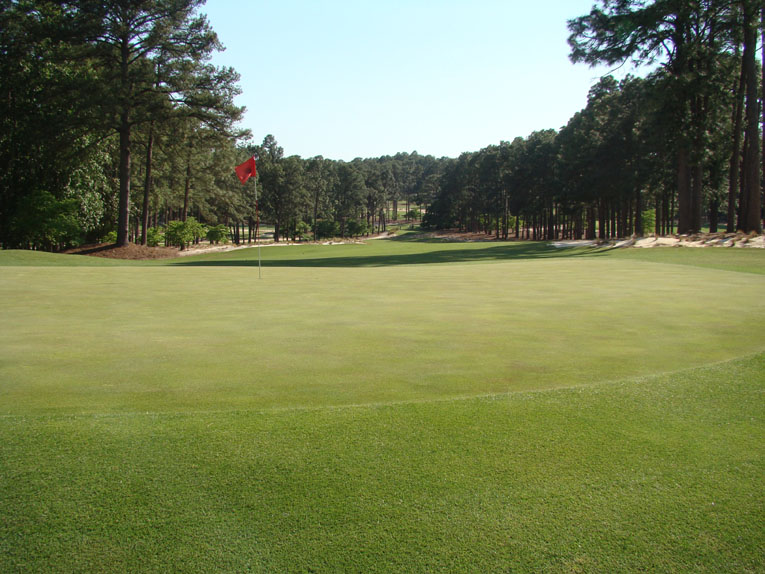
As seen from behind, the seventh green follows the natural grade of the land and drops four feet from back to front. The out of position golfer can readily have a putt that breaks a dozen feet or more.
Eleventh hole, 165 yards; After having lived at Mid Pines for seven consecutive months and on the course every one of those days, Franz says that his appreciation for Ross’s work has only grown. For example, this green complex features a knob front right that can be used as a kicker to feed balls toward back hole locations where the green narrows. Franz contends that playing a draw into this green as Ross intended is one of the more rewarding shots on the course and he loves the slow drama of watching the ball release off the kick mound.
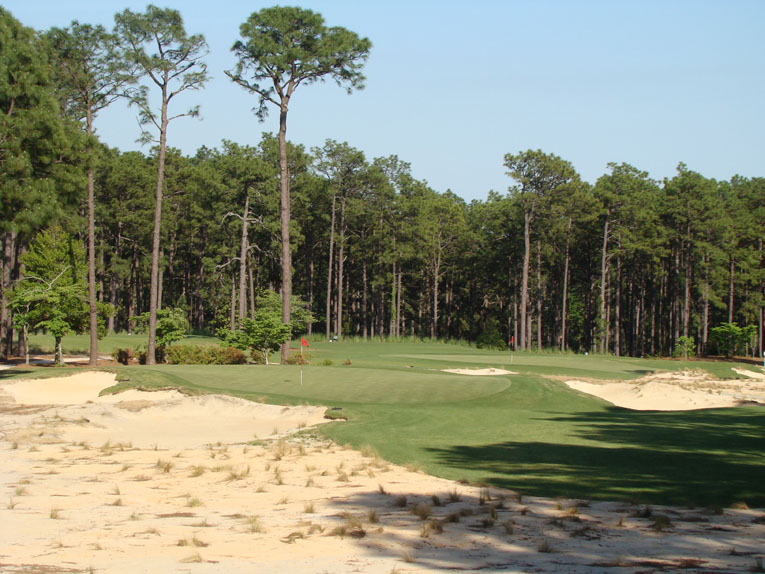
Much longer than it is wide, the eleventh green occupies a high spot on the property. Given the recent tree removal, golfers now need to pay particular attention to the wind when selecting their club.
Twelfth hole, 380 yards; Similar to the fourth green complex, this long narrow angled green occupies a special place among the 7,000 plus green sites that Donald Ross designed over his forty-seven year career. Protected by bunkers right and left, the sliver of green, which angles from front left to back right, is fifteen paces wide in parts. Any approach from the right side of the fairway is at an awkward, oblique angle to this shallow green.
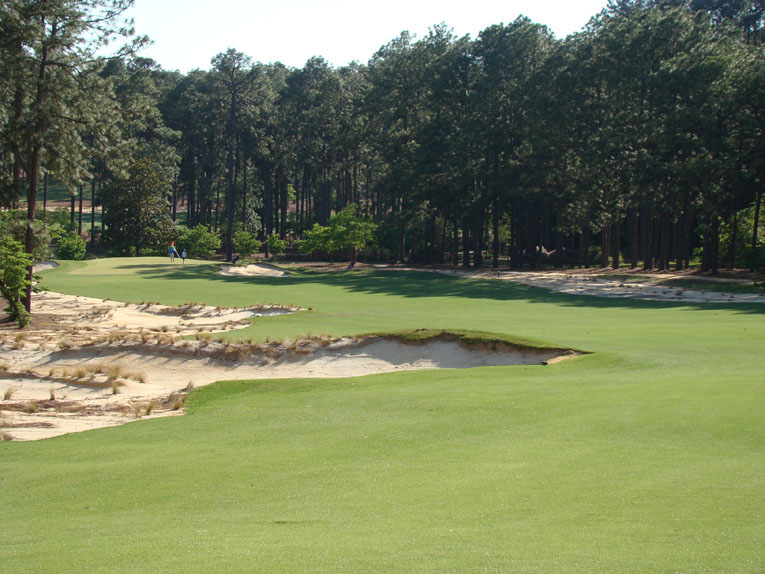
Classroom 101 in how to design a hole: Provide a hazard that must be carried to obtain the best angle to the green. Gobs and gobs of short grass exists to the right of the fairway bunker but the front left to back right angle of the green becomes problematic.
Thirteenth hole, 235 yards; Ross and other Golden Age architects had no compunction about requiring the player to hit a wood on a par three. Indeed, many viewed it as a necessity. After all, they reasoned, such holes only add variety to the course by making players hit every club in the bag. Certainly a hole like this helps explain why the talented golfer Bobby Cruikshanks once noted, ” Any man who breaks 80 on that course on his first or second round is a golfer.” He said that in 1921 when hickory golf prevailed and the course measured less than 6,400 yards. Golfers today are impressed that this 6,750 yard course still seems to make them hit every club in the bag.
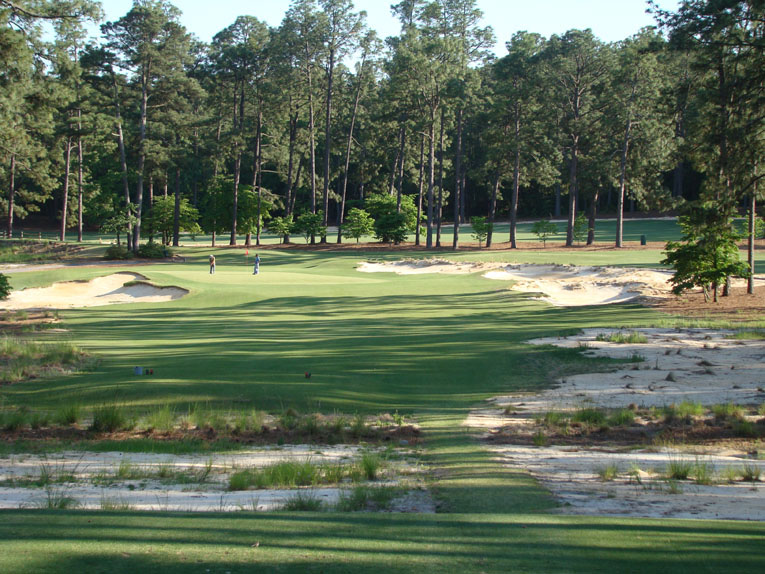
Built in the days of hickory golf, a hole of this length required that the green be open in front to allow for a run up shot. Ross provided that but also a right to left slope near the green that can be used to help chase the ball onto the putting surface.
Fifteenth hole, 480 yards; Routing holes across broadly sloping terrain is tricky. Without sufficient width, the golfer may be made to feel like a billy goat. Fortunately, Donald Ross had ample width at his disposal and made the most of it here. Instead of an awkward hole around the higher edge of the property, Ross designed a hole that is fun to play. A drawn tee ball over the left edge of the right bunker takes the fairway slope and runs for forty plus yards. Advances in technology have brought this green into reach for many golfers and hitting the green in two is quite satisfying.
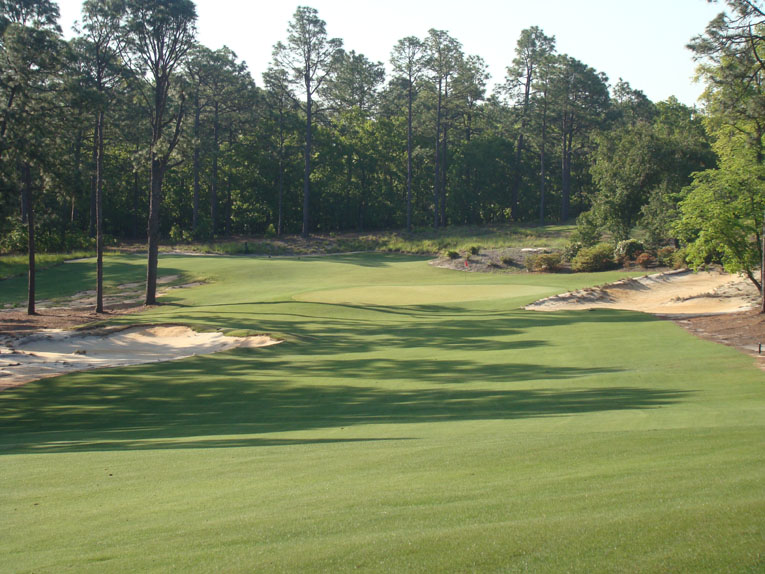
Though reachable in two, note the sloping fairway. Achieving a good strike when the ball sits well above a right handed golfer’s feet is no mean feat.
Sixteenth hole, 430 yards; Moore County is famous for both its sandy soil and its rolling topography. Mid Pines features both. The sixteenth tee is high on the rim of the property and a well struck tee ball soaring into the valley makes for one of the prettiest ball flights in Moore County. Franz’s new back tee adds 30 yards to the hole so it again plays as Ross intended (i.e. a big hole requiring some sort of mid iron approach). Despite the demands of the hole off the tee, the domed green with its high middle section is where strokes most likely add up.
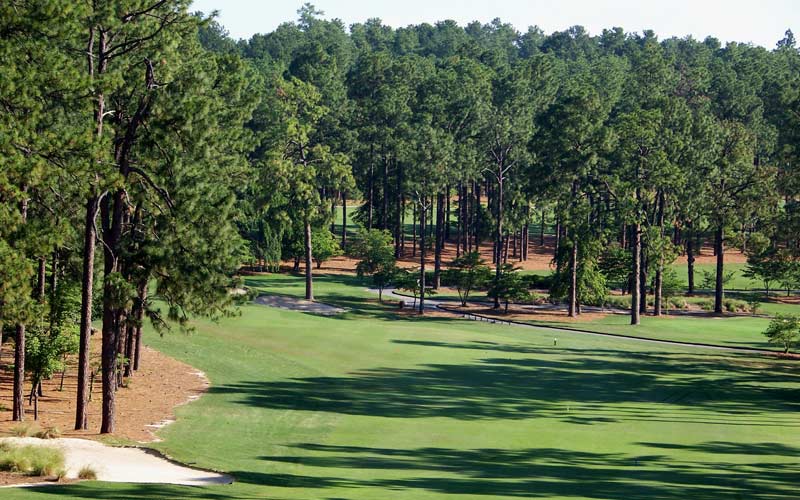
This ‘before’ picture was taken in 2007. Though the tee shot provided a commanding view, the hole lacked the scale and strategic merit we see now.
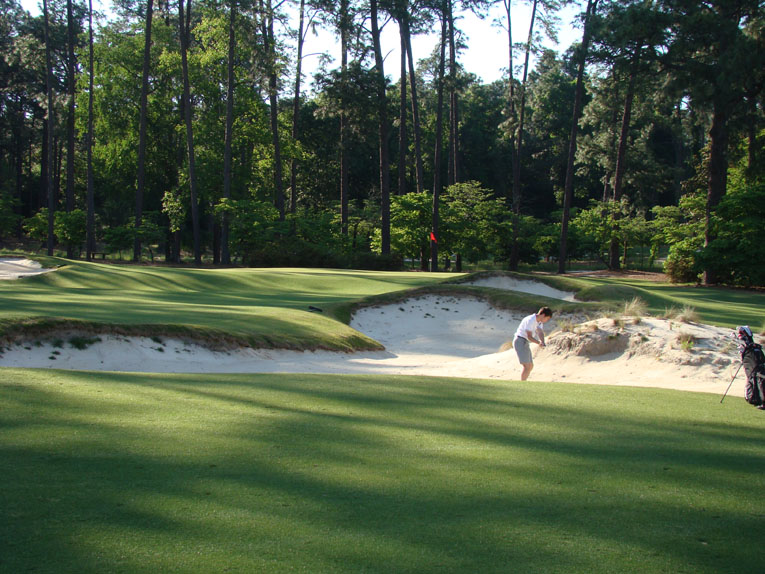
Golfers who get tangled down the left often over play their second into this right side bunker complex. No golfer likes a 40 yard explosion shot!
Seventeenth hole, 390 yards; A highly regarded dogleg, this hole sweeps to the right. A power fade is handsomely rewarded off the tee, leaving the golfer a clear view of the green. The golfer whose tee ball is played more cautiously to the left must confront a pair of bunkers at the left front of the green. In short, the perfectly conceived bunker scheme enables this penultimate hole to hold its head high with both the sixteenth and eighteenth holes, both of which enjoy greater topographic interest.

Relatively flat, Ross summoned his design skills to help make this hole the equal to other, more naturally blessed holes.
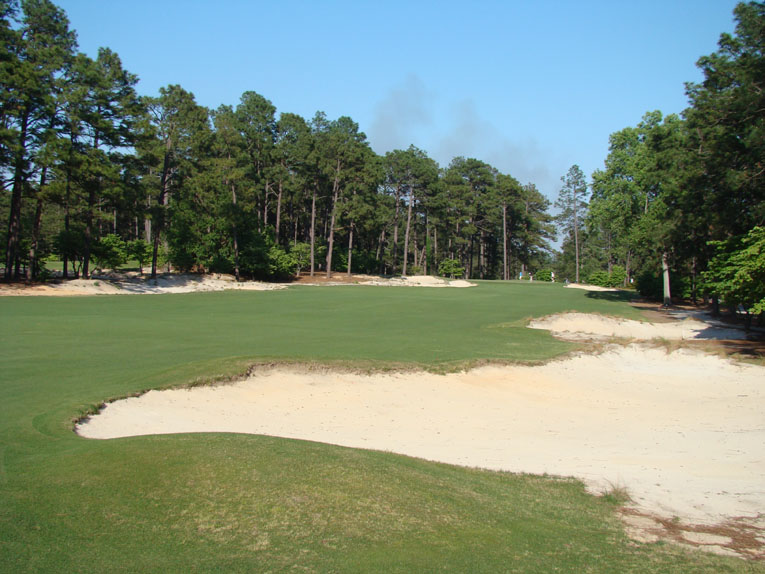
The patch of fairway beyond this bunker is not readily evident from the tee but is the ideal position from which to approach the green.
Eighteenth hole, 410 yards; The one requisite of a great Home hole is to provide a sense of occasion. There are many ways for finishing holes to accomplish that and this is a prime example. From the tee, the golfer enjoys a long view down the hole and a glimpse of the impressive Mid Pines Inn in the distance. David Eger, the 2000 North South Champion, considers this to be the finest finishing hole in the state.
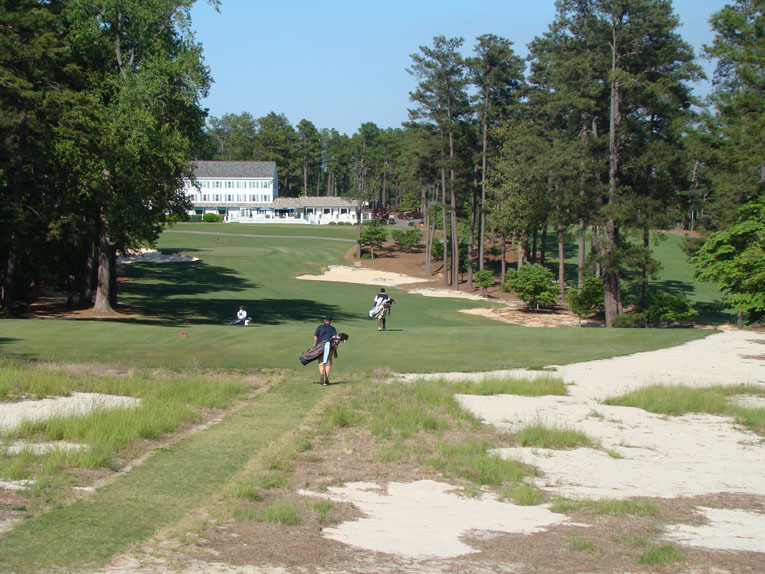
Given that the first hole plays downhill, it is unusual that the Home hole also plays downhill. Its elevated tee provides a majestic vantage point that is amplified …
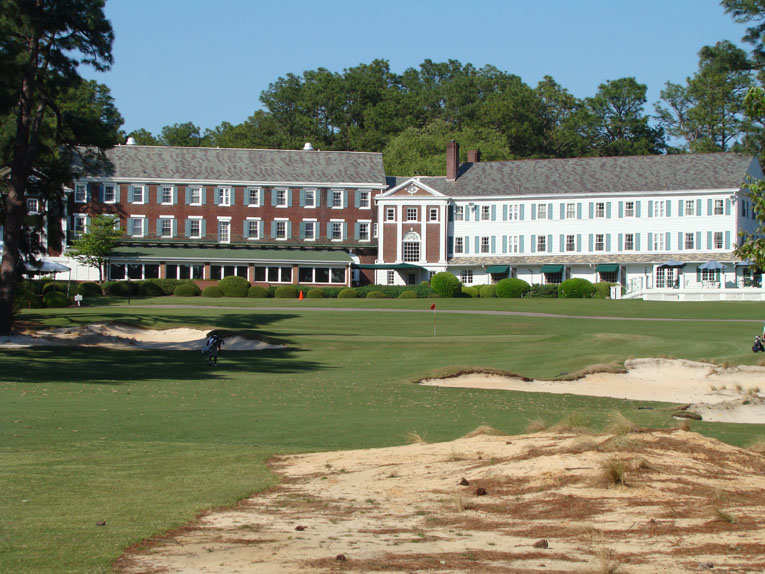
Plenty of on-lookers from the handsome hotel regularly watch the proceedings unfold on the back to front sloping Home green.
The closing stretch at Mid Pines comprises three sterling par fours in a row. That’s the way it should be as the par fours in particular are the design highlight of the course. The first, fourth, seventh, twelfth, and the final three offer both varied and compelling golf for all skill levels. The potential of this set of holes (as well as the course in general) has now been fully realized thanks to the 2013 restoration work. As such, Mid Pines has gone from a charming place to have a game to a charming place littered with great holes to have a game.
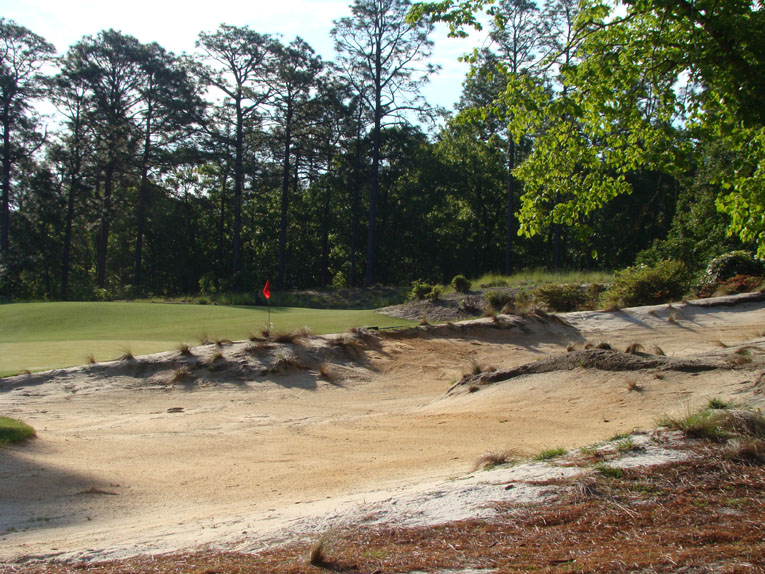
Mid Pines’s resurgence means that the Pine Needles-Mid Pines Resort now offers quite the one-two punch. For those that like their golf on well manicured surfaces, there is Pine Needles. For those that find great beauty in the native state of the sand hills of North Carolina, there is Mid Pines. Best yet, the resort guest is free to rotate between the two!
The End


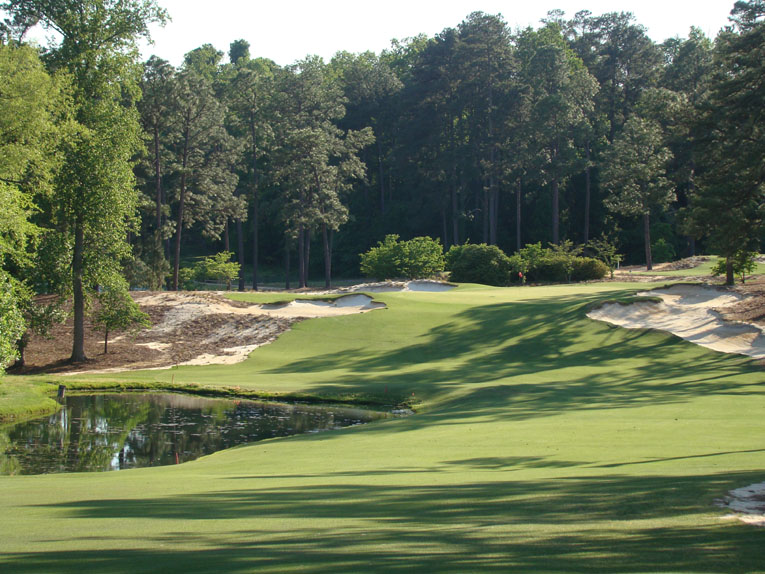
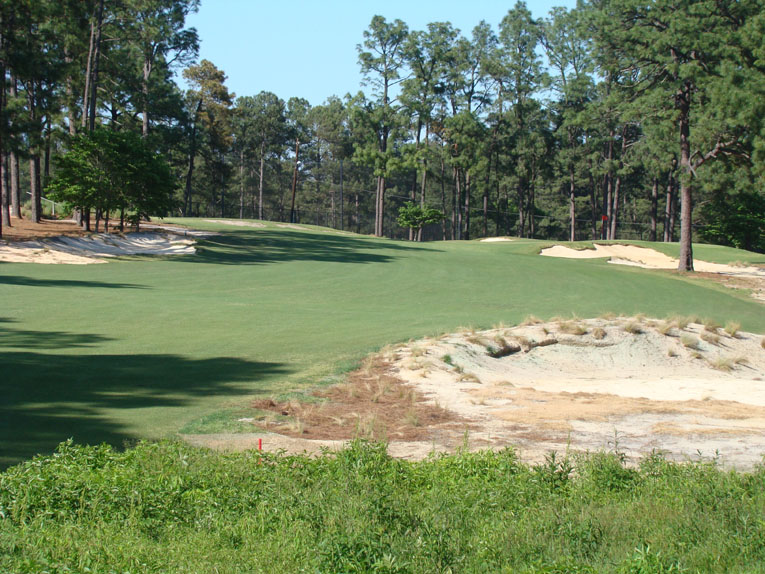
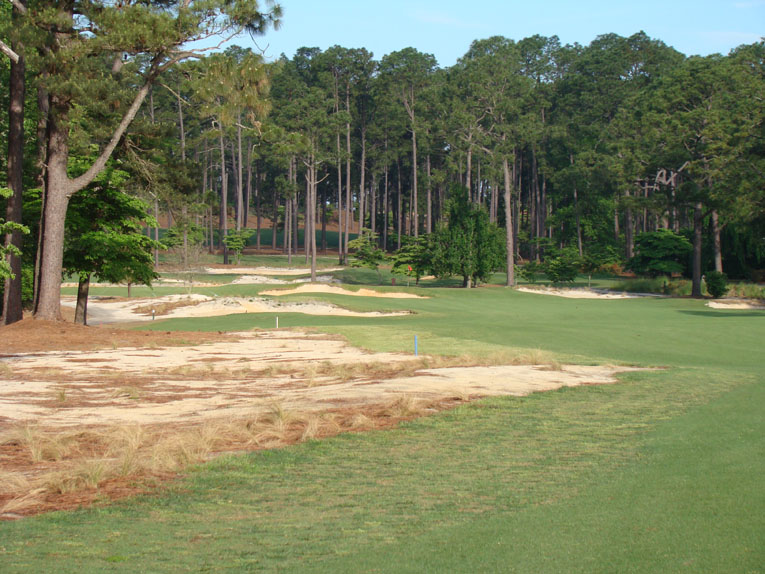
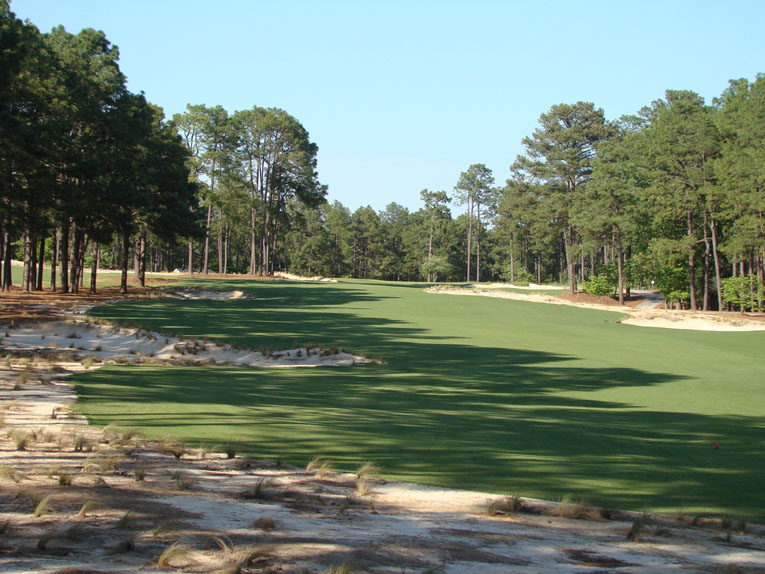
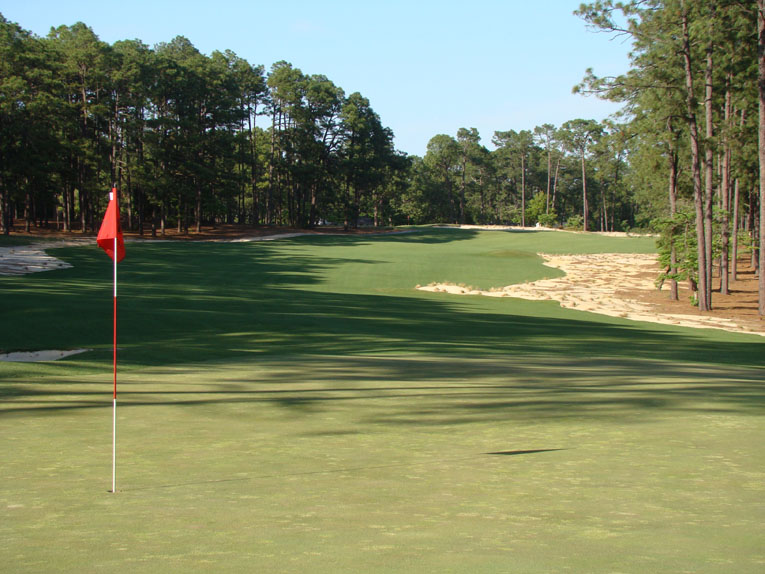
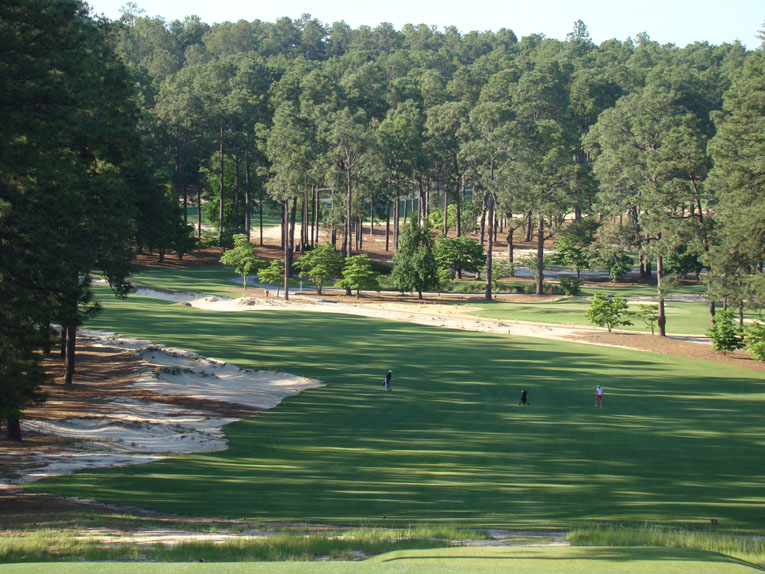
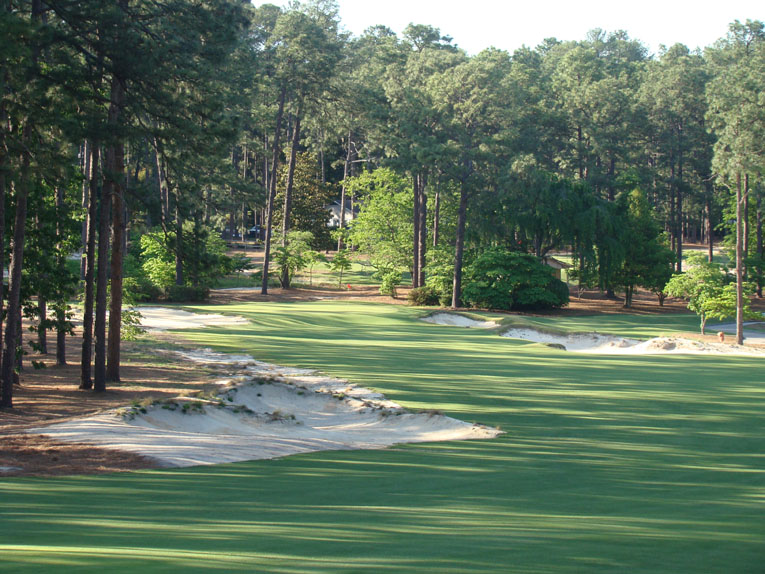
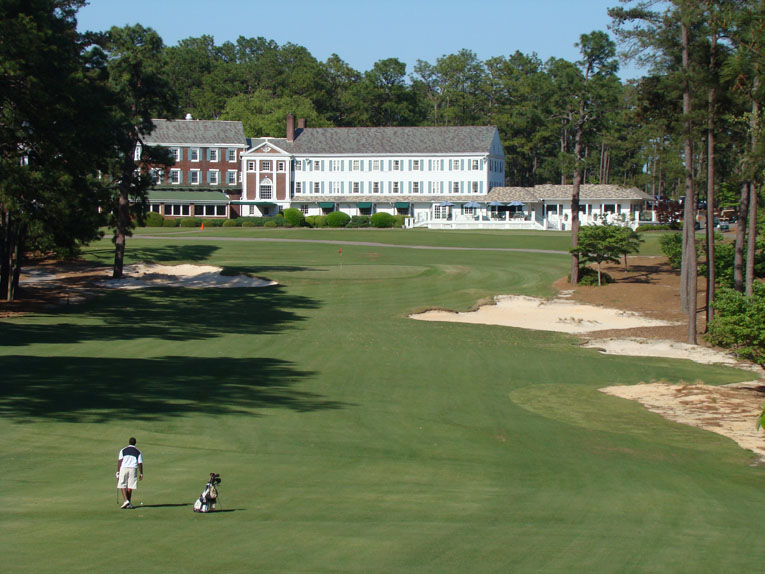



![The Park, West Palm (Lit 9) [2023]](https://golfclubatlas.com/wp-content/uploads/2024/12/IMG_7092-2-scaled-500x383.jpg)


